
|
||
|
Portland art blog + news + exhibition reviews + galleries + contemporary northwest art
|
||
COLLECT FOUR at White Box 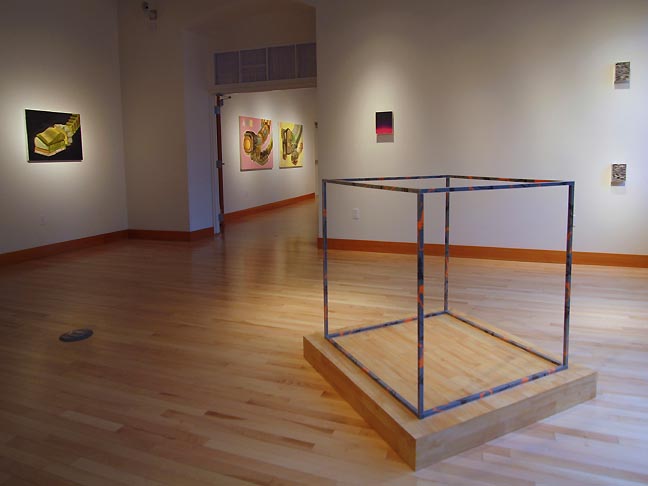 Installation view (L to R)Jason Trager Unitled 1, 2, 3 Midori Hirose Gradient, SQT, BWI, BWII Artists have generally been better at finding new talent and trends than curators, critics and institutionally originated surveys. For example Paul Gauguin helped put on salons of impressionist painters, Kandinsky and his cohorts put on der Blaue Reiter exhibitions, Damien Hirst put on a series of warehouse shows that defined the YBA's and Takashi Murakami's Superflat shows presented a whole different understanding of Otku culture to an international audience. Often the artist organizing the shows has work in the exhibition because it is a self-organizing system as opposed to something cobbled together by an outsider. These self-organizing shows bring a different kind of legitimacy than an institutional curator will. Overall, it is very important that artists not abdicate their right to organize and self select the contexts by which they are framed. Indeed, part of what makes Portland's scene so vital is the amount of this kind of activity, be it Rock's Box, Appendix, Half/Dozen, last year's Ontologue show, Tractor or the shows Modou Dieng puts together at Worksound... even the fact that Kristan Kennedy is an artist curating the TBA festival's visual art segment. All give the scene a certain boots on the ground legitimacy that money can't buy. Maybe these aren't always the tightest programs (although some are) but they do have a certain energy of discovery that makes them laboratories of culture. More artists should curate shows and more institutions should host such experiments. The latest in this grand tradition is COLLECT FOUR: Scenes from Portland's Bleeding Edge at the U of O's White Box Gallery in Portland. Curated by Jesse Hayward (one of the scene's most consistently radical artists) it effortlessly delivers the kind of focused sampler we expect from Biennials and art awards yet seldom are treated to. 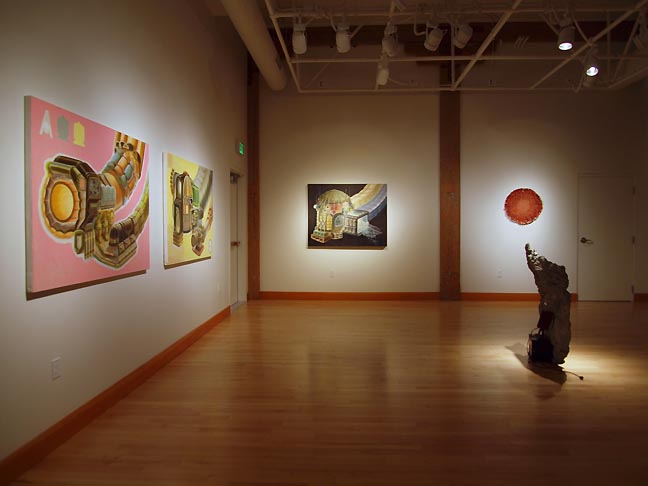 Installation view (L to R) Jason Traeger Unitiled 2, 3, 4 and Benjamin Young's Ejection & Self Help Hayward isn't discovering anyone here, but he is giving four of Portland's most promising recent talents; Benjamin Young, Jason Traeger, Matthew Green and Midori Hirose a nice stage to spar and highlight one another upon. Does it need an overarching theme, no? The fact that as Hayward describes each of these artists as “collectors” in their own right doesn’t really matter... all artists collect something (usually insults, suffering, headaches and debt) but that is his conceit. Hayward as the phantom artist here has collected four practitioners he find's interesting and unlike a lot of institutional curators lets the artists play off of each other to highlight their differences and strengths. In fact these four artists each reflect facets of Hayward's own work. 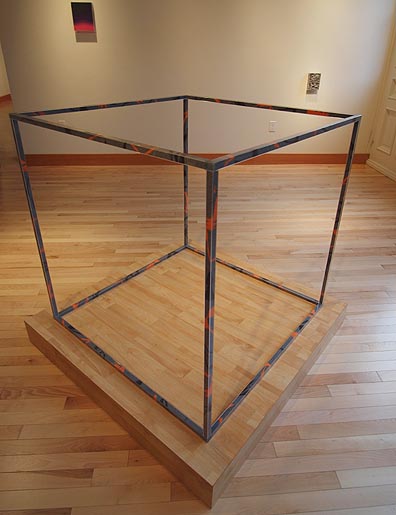
Midori Hirose's SQT (FG) Upon entering the show the viewer confronts the strongest and most developed piece in the show, Midori Hirose's SQT. SQT is cube whose acrylic supports are filled with orange, grey and black sand. It's a wry and intense piece about the provisional making, presentation and care of art objects and it is stronger than anything I've seen from her to date. 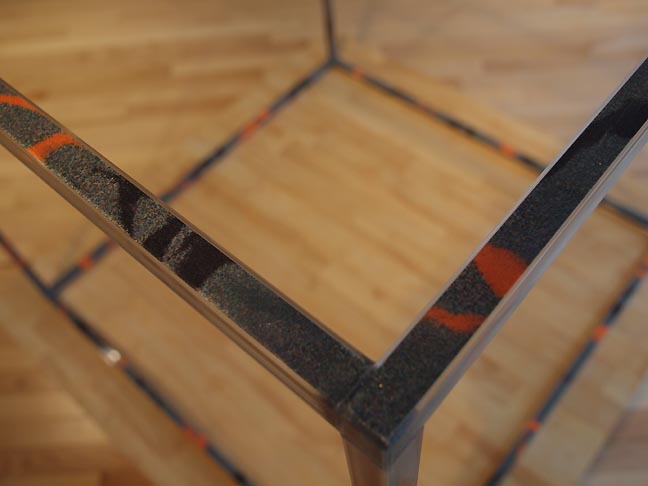 Hirose SQT (detail) What works is the way she acknowledges the indeterminacy of pigment without using paint. This non painted cube references Sol LeWitt and other minimalists but she acknowledges the accretive charm of material and how shifty actual objects are (despite what some art schools teach). For example, if SQT is shaken enough I suppose it's indeterminate painterliness would simply mix into a brownish grey, becoming like older minimal art that has been done already much better. Instead, SQT acknowledges the fragility and process of art, thereby answering the anti-object camp of art thinking with an object that is just as performative in its stasis as performance art... recalling the work of Yves Klein. Even the plinth constructed to match the floors works exceptionally well. Her other three container pieces, Gradient, BWI and BWII are also successful as non painting paintings. It certainly looks like Hirosi has come upon an original idea since breaking out in 2009 and deserves a focused solo show to fully present and develop this new body of work. Well played... this is exactly what the Portland 2010 show should have done instead of presenting so much old work. Hayward has a knack for this kind of prescience, perhaps because he chooses artists not specific pieces, then asks the artists to bring their best game. I hear Hirose even chose not to show the strongest piece she had created for this show but withheld it because it didn’t fit... that's the kind of restraint that tells me she's the real deal. Lots of artists make nice work, it's rarer to have one who knows how to edit and create a nice show from that work. 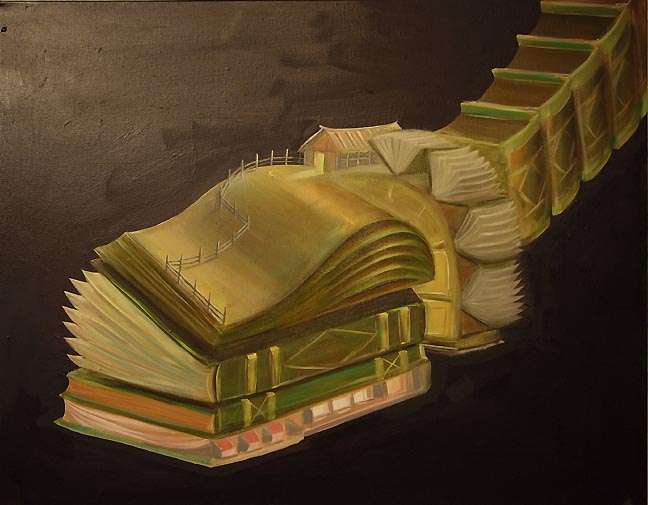 Jason Traeger's Untitled 1 Jason Traeger's Untitled paintings 1-4 mark a moment of real growth for the artist. In the very recent past (on display at PSU right now) he would fill his Max Ernst meets Neo Rauch excursions populated with claustrophobic serialized vacuum cleaner parts, heraldic symbols, books and references to Hindu imagery. It all resembles Traeger's installation art. Inherently occult, the early paintings were interesting but exemplified what Nietzsche once famously described as attempting to, “Muddy the water, to make it seem deep.” By comparison, in their mature works both Rauch and Ernst allowed enough space for the viewer to create absurdist narratives, whereas in the past Traeger's dense has choked off any absurdist narrative before it could form in the viewer's mind. 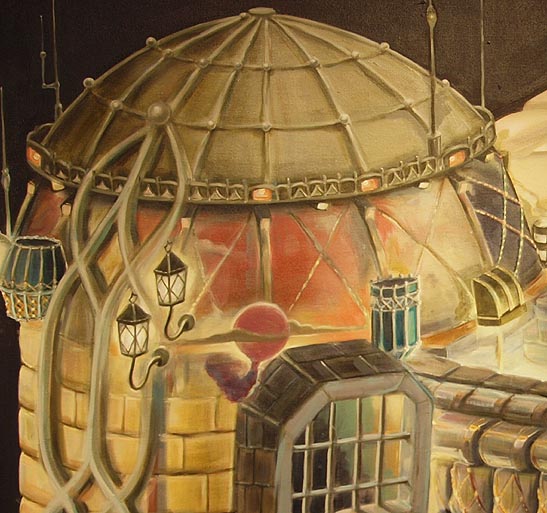 Untitled 4 (detail) In COLLECT FOUR Traeger seems to have gotten the message from his predecessors. In Untitled 1 (his latest painting, literally drying on this wall) we are lead from right to left down a cascading avalanche of books to reveal a book with a homestead with some kind of simple yey exotic structure. It's a Dali-esque or Magrittian move that doesn’t totally work (the proportions of some of the books on the right seem bit off) but it does provide the occult microcosmic organs Traeger is so fond of, allowing the scene to give birth to a microcosmic ideal.. Perhaps that is Traeger's true subject matter... the foreboding sense of a larger mysterious universe and the quaint solipsistic familiarity of what we hold dear as an comfortable. In this sense it is very much painting of our times but I think Traeger is still looking for a better microcosmic/idealistic subject to menace with all of his occult organs of mystery. The colors in these paintings are also less muddy than previous works and are better highlighted by the rich black or pastel grounds as a kind of stage of mystery allowed to unfold. Overall, I still prefer his installation art, besides his paintings look almost like set diagrams. As viewing any mature Ad Reinhardt painting exemplifies, being completely impenetrable reduces the mystery. Instead, just a tiny bit of something simple and mundane, yet difficult to fully perceive is the way towards success. Right now Hirose's work is actually more mysterious and seemingly occult than Traeger's. That will change if Traeger pursues this new path further. Traeger's paintings in the second room are cousin's to the work of Benjamin Young who also has his roots in Germanic surrealism but but instead of Ernst and Rauch it is Meret Oppenheim, Joseph Beuys and perhaps Martin Kippenberger's combines that are in play. Though it's Beuy's influence that is strongest. The installation on the floor Self Help consists of a Die Hard Battery an unplugged strobe light and a grey slab of material (like a rock climbing wall) with a little spray paint on it. It's a pathetic object and like Beuy's sleds with flashlights, felt and fat it seems like some arcane kind of preparation to be used at the appropriate time (which has either just passed or looms nigh). It's very Kippenberger-esque as well but the words Die Hard on the battery have a lot more activism about them than he would have used. It is as if the project might have been somewhat aborted after a long protracted battle and the piece simply ran out of juice? It isn't great, and it isn't terrible it just seems somewhat still born compared to the work of Iza Genzken or Rachel Harrison who are masters of this kind of “Unmonumental” combine style. Yet, I think it is better than if the light was on and strobing in the room, which would be distracting and even less original. 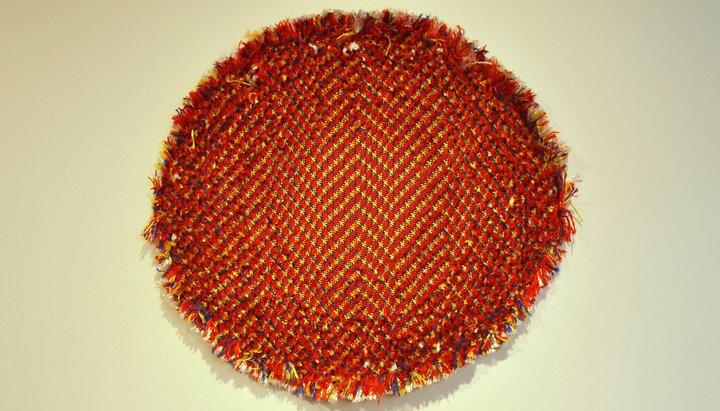 Benjamin Young Ejection Much more exciting is Young's Ejection, a zigzag patterned circular mat woven from a climbing rope on the wall. It implies a kind of rearrangement of priorities away from mountain climbing (perhaps a metaphor for the physical) towards a more inwards meditation. The fact that it is woven is also exciting, transmuting a very utilitarian conquest oriented symbol to a more personal and craft-oriented or process driven totem of enlightened rigor. It makes even more sense when connected to Young's final piece in the show The Last Thing Ever Born. 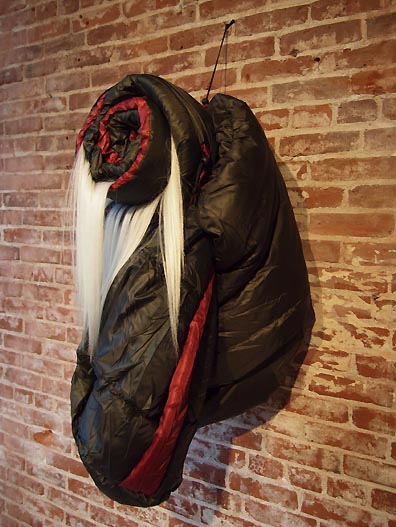
The Last Thing Ever Born Once again this piece owes a debt to Beuy's shamanistic/dadaistic approach with the fetally curled yet womb-like sleeping bag anchored to a refreshingly non white red brick wall. This too is is a study of macrocosm and microcosm, perhaps even mother and child with a funny beard to signify a kind of dadaist ancientness. The piece is is neo tribal like Forcefield and implies a kind of creation myth origin and explanation for the mysteries that artists engage. It isn't as sexually fetished as Meret Oppenheim or the least bit debauched like Kippenberger.. or even as sci-fi/architectural/campy as Oregon Painting Society but it does look like Young is a young shaman looking for his vocabulary. Is Young's mature vocabulary going to be related to the great outdoors as the climbing rope and sleeping bag suggest? Young is another artist who really requires the full force of a solo show to gauge fully. 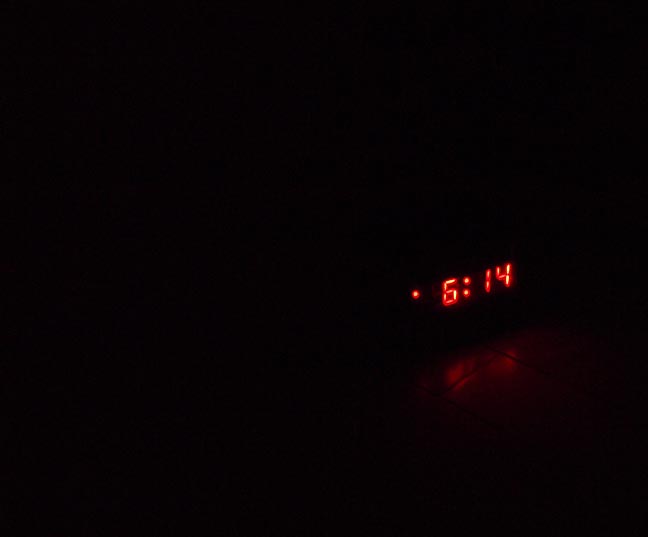 Matthew Green Friendly Reminder Last but not least is Matthew Green's Friendly Reminder, which consists of a single red LED alarm clock, the kind that everyone has and loves to hate for its relentless and arch annoying BEEP BEEP alarm. It sits in the back corner of the Grey Box room normally darkened for video and as an exercise in omission while time slips by it does show a certain amount of restraint I didn’t see in Portland very often until about 2004. Overall, the piece is more of an art school “move“ than a statement like the other works in the show. Think of it as a deflection or an erasure as Green takes up the most space with the smallest and least idiomatic object in the show (which is his point, instead of producing an object he is occupying resources like time and space). It's the kind of defensive ploy I often see from current and recent MFA grads because it reserves its place with guts (and not much else) rather than set the table. The alarm is set to 4:20 apparently the time when stoners like to get high. This too is a negation though the use of the clock sets up a certain expectant attitude. I believe Green is worth watching but by trying to play it so cool he's already telling us he needs a little more time Or perhaps he's asking us to bear with him, something great is coming? Will 2011 be the year Green stops deflecting and follows through on his exceptional Nilbog piece from last year (itself a negation and a nerdy subculture digression but ultimately exciting)? Is Friendly Reminder simply Green asking viewers to reserve some attention in the future for him, if so he's somewhat successful but he can only use this move once. Overall, the exhibition helps explain why so many curators watch Hayward and who he watches. All four of the artists here are improving and or showing that they can produce attention getting work if asked to. Group shows like COLLECT FOUR are rarely conclusive triumphs but as it stands this is perhaps the most promising group show we will see all year, it all depends on what these four do next in solo shows? Through March 16th White Box in the White Stag Block 24 NW First Avenue, Portland Tuesday-Saturday, noon-6 p.m. whitebox@uoregon.edu | 503.412.3689 Posted by Jeff Jahn on February 23, 2011 at 9:34 | Comments (1) Comments Excellent review. Hayward is easily one of the most thoughtful artists in town and it shows in his work, and this exhibition. I laughed when I first heard the title for this show. I thought it was biting off more than it can chew, by essentially saying it was serving as a representation of what is currently being done in our region. However, somehow Jesse successfully displayed our neo-hippie ways before us, and presented it in a way that feels less like a cliche, and more like commentary on our region's interest in being a place for nature lovers, "others", crafters, and some stoner burn-outs. I might be doing a short little write-up about this show as well. It certainly deserves to be written about. Posted by: Calvin Ross Carl Post a comment Thanks for signing in, . Now you can comment. (sign out)
(If you haven't left a comment here before, you may need to be approved by
the site owner before your comment will appear. Until then, it won't appear
on the entry. Thanks for waiting.)
|
| s p o n s o r s |
 |
 |
 |
 |
 |
 |
 |
 |
 |
 |
 |
 |
 |
 |
 |
 |

|
Site Design: Jennifer Armbrust | • | Site Development: Philippe Blanc & Katherine Bovee | |


![[TypeKey Profile Page]](http://www.portlandart.net/nav-commenters.gif)